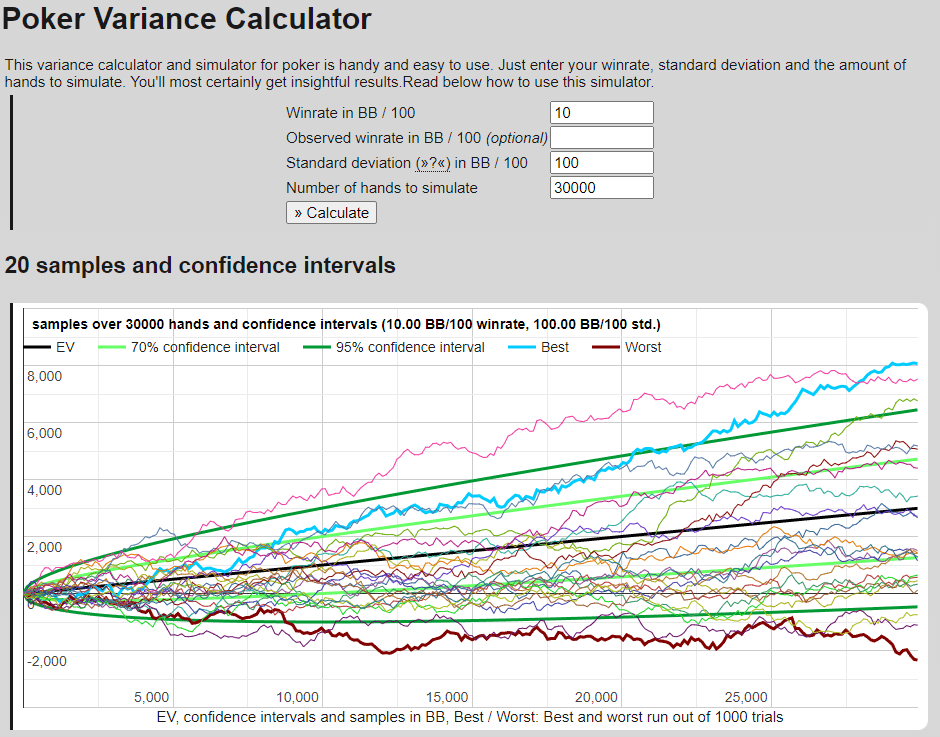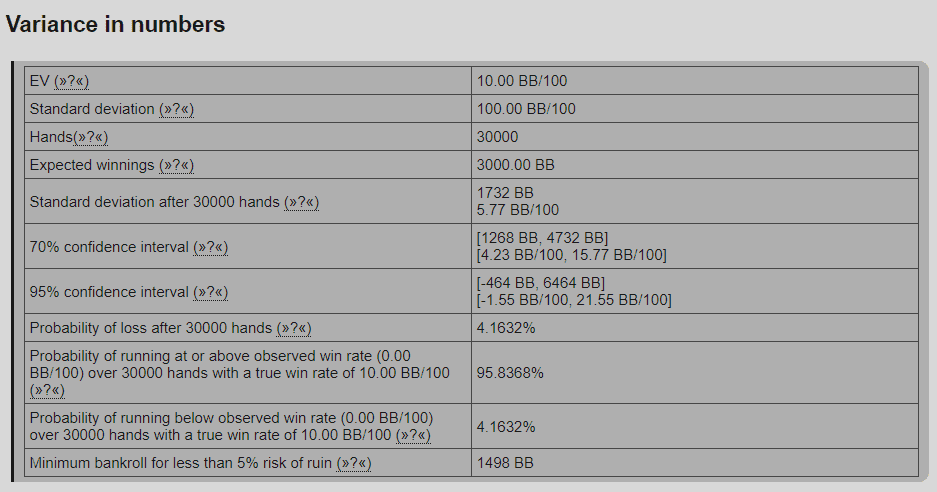Poker is a very competitive game, and success is challenging to achieve. So you should seize every opportunity, every little edge to add to your income and stay ahead of the competition. So why not start this before even playing a single hand at the tables?
Fundamental bankroll management tips – how variance works
a. What is variance, and why should you know about it?
We need to start with an explanation for those unfamiliar with mathematic concepts. What is variance, and how does it work in poker? Besides that, why is it essential for a poker player to understand this concept?
In probability theory and statistics, variance is the expectation of the squared deviation of a random variable from its population mean or sample mean.
Let me explain this. When you examine the probability of an outcome, variance is the tool/measuring number you can use to compare the ratio between the expected value and the deviance depending on a certain sample size. I.e., when you toss a coin, the outcome is either heads or tails. The chance of the result is 50-50%. If you take just one shot, the actual outcome will be either A or B, 100-0%. The theory says that the more significant sample you examine, the closer you get to the expected value of the event. In case of infinite sample size, we'd reach zero deviance from the expected value (in case of coin toss 50-50%). The other way around, the smaller the sample you are looking at, the bigger the chance of deviance from the expected results.
Okay, but how is it important in poker, you might ask? Do you know how much money you should keep as a bankroll? What stakes can you afford to play on? I'm sure you've already found some contradictory opinions about it. The truth is that nobody knows exactly. Why is that? To determine, we need to consider some variables. It means that the answer varies depending on the circumstances.
b. Real-life example
Let's say you are a 5bb/100 winning player in 6-max cash game. If you play just one hand in the month, you will either win it or lose it (or chop the hand). Which outcome can differ all around the spectrum in terms of bb/100. If you play 1000 hands, the possible outcome will be closer to the expected value but still with a considerable possibility of variance. You could lose by many buy-ins or the other way around, still deviating from the initially expected 5bb/100 value (on 1000 hands, it would mean 50bb profit).
How many hands do you play in a month? Let's say that the standard amount for an online poker player is 30.000 hands. With the help of the poker variance calculator (https://www.primedope.com/poker-variance-calculator/), let's examine the possible outcomes.
The calculator shows the expected winnings (1500bb – 15 BI); this "should" be your winning result based on the quality of your game. But the sample is finite, which could lead to massive deviance between the expected and the actual outcome. In this case, the standard deviation (by how much your actual results will differ from the anticipated results on average) is 1732 bb, 5,77 bb/100. (take into consideration that the size of the deviation is larger than your expected winnings, which means a slight but possible ruin in this sample).
c. What other factors to take into consideration?
Each case is different. In practice, you might want a bigger or smaller bankroll. If you wish to take more risks, you might start with less money. You can always move back stakes, so you don't risk your entire bankroll if you follow the adequate amount of bankroll to the smaller stake. For example, if you move down stakes each time you have only 30 buy-ins for the smaller stake (keeping the same winrate), you'll never go broke.
Also, be cautious; your winrate will be affected by many variables. The higher the stakes, the better the opponents. You might want to estimate your winrate lower than on your base stake. At the same time, the smaller stakes you play, the higher the rake will be. Eventually, reducing your winrate by a hefty margin. (If you need more detailed explanation how the rake is collected, check out this article). Always think about your bankroll and variance as a constantly changing, dependent-on-the-circumstances phenomenon.
If you have a sample or a good guess, you should play around with the numbers. Check out how many hands you want to play in a month or a year and what it means in terms of variance.
There are other factors to consider when you define your bankroll and stakes to play at.
Your personality is a crucial factor. If you don't take losses well and are risk averted, you should have a bigger bankroll. In addition, the short run might affect your game, which means that you are not playing your A-game all the time, which leads to a lower winrate. To avoid going broke, you should probably set up a 100 buy-in bankroll to feel comfortable.
If your goal is to move up the stakes fast, and you beat the lower ones by a margin, then you'd probably go as low as 15-30 buy-ins.
Summary
Always think about what you would like to achieve and remember the variables that affect your decision-making regarding bankroll management. It's safe to say that it's better to be more risk averted than jeopardize your bankroll or poker career, especially at the beginning of your journey.
Read our next article for tips on getting an advantage over your opponents.





















0 comments